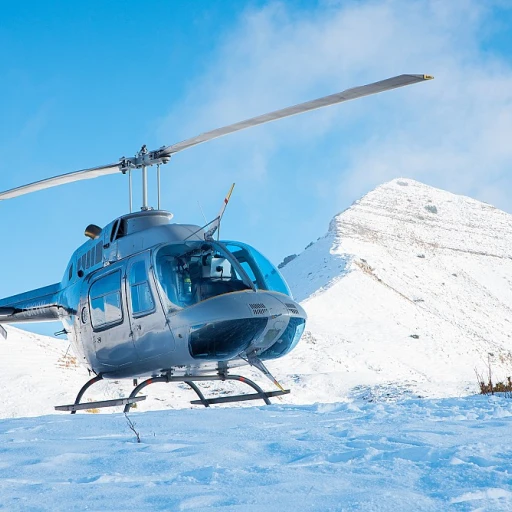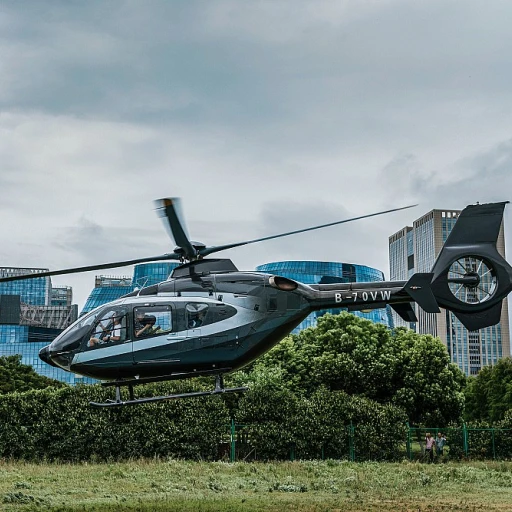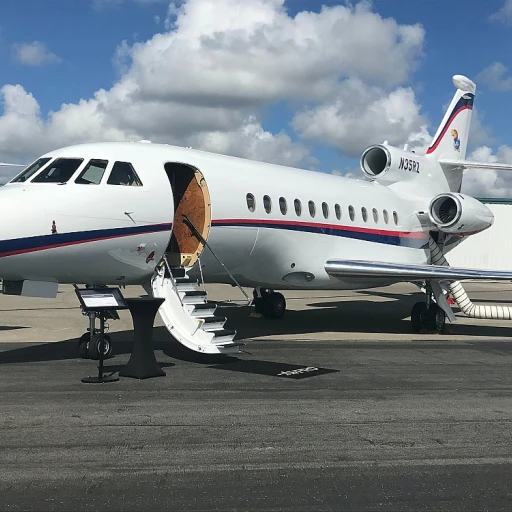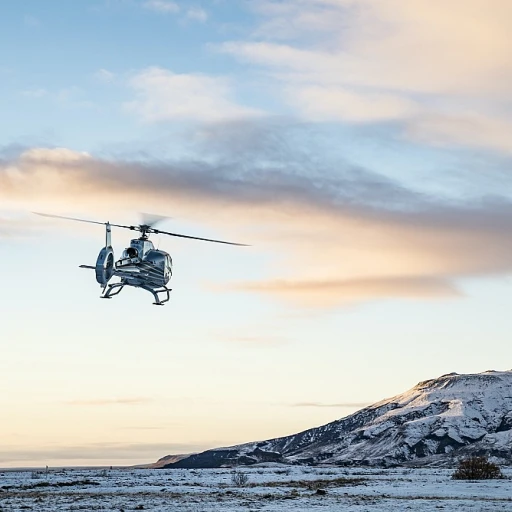Introduction to the smallest private jet
Introducing the world of compact luxury in private jets
Fancy sipping champagne at 40,000 feet, but don’t need an entire airliner to get you there? Ever dreamed of a jet that offers both the luxury you deserve and the convenience of a smaller size? Well, that dream might be closer to reality than you’d think. The smallest private jets have become increasingly more appealing for individuals and businesses seeking the perfect blend of luxury, efficiency, and cost-effectiveness.
The beauty of these small private jets lies in their compact size which brings flexibility. You can land at smaller airports, giving you access to more destinations. Whether you're flying from New York to Miami or hopping between European cities, these little marvels have you covered.
When talking about the smallest private jet, the Cirrus Vision Jet often steals the spotlight. Weighing a mere 3,700 pounds, it’s designed for those who need efficient, quick, and cost-effective air travel. Cirrus Aircraft really nailed it with this one, sparking interest and intrigue across the aviation globe.
However, it’s not just about size; it's about what fits inside. From deluxe seating to sophisticated dodads like the Garmin avionics suite, these jets redefine luxury on a smaller scale. Passengers can expect a cozy yet swanky cabin, one that doesn’t sacrifice comfort or style.
Talking about performance, speed, or range of these aircraft is pretty fascinating. Top models like the Honda Aircraft Company’s HondaJet and the Eclipse 550 jet are renowned for their impressive range, nautical speed, and reliability, despite their more petite frames. Stay tuned, as we will dive deeper into these aspects later in this article.
The rise in demand for these compact jets also speaks volumes. More and more jet-setters are hopping onboard, driven by the desire for seamless yet luxurious air travel. There’s ample market data that highlights this growing trend, with light jets experiencing a market uptick of nearly 10% over past few years, as per market research by JetNet in 2021.
So, whether you’re a business mogul wanting to dash between meetings or someone seeking leisurely, hassle-free travel, the smallest private jets might just be your perfect match. These flying beauties combine the best in comfort and performance, offering an unbeatable aerial experience.
Thinking about stepping into the arena of compact luxury? You might want to also explore how innovative designs are reshaping this segment. Click here to read more about cutting-edge designs in the jet world.
Top models in the smallest private jet category
Exploring the elite: top small private jet models
The realm of small private jets is brimming with some tremendous options that ooze luxury and performance. A few standout models have garnered attention due to their blend of compact design, range, and incredible cabin comfort.1. Cirrus Vision Jet
The Cirrus Vision Jet is celebrated as a marvel in the very light jet (Vlj) category. It’s an ideal choice for those after a small private jet with exceptional performance and comfort. This single pilot jet can cover a range of approximately 1,200 nautical miles with a speed of around 311 knots. The manufacturer equipped it with the Garmin G3000 avionics suite, ensuring both safety and convenience.2. HondaJet HA-420
Unveiling a perfect balance of luxury and technology, the HondaJet HA-420 stands out with a range of roughly 1,400 nautical miles and a maximum cruising speed of 422 knots. Honda Aircraft Company designed it to offer a spacious cabin despite its compact size, featuring a fully enclosed lavatory, a rarity among small jets. The jet is a frequent choice among business travelers, thanks in part to its quiet cabin and impressive speed.3. Cessna Citation M2
The Cessna Citation M2 is the epitome of efficiency. Known for its speed and agility, this light jet can go up to 1,550 nautical miles at a speed of 404 knots. It's perfectly tailored for those requiring a swift commute that doesn’t compromise on amenities. Pilots appreciate its simplistic yet advanced avionics, with the jet widely used in corporate and charter services.4. Aiming High with Embraer Phenom 100
The Embraer Phenom 100 combines a sleek design with powerful performance. Flying at 390 knots, it offers a range of approximately 1,178 nautical miles. Its superior baggage capacity, fully enclosed lavatory, and remarkable passenger comfort make it a smart pick for both leisure and business trips. The cabin's height and width provide a comfortable atmosphere for those on board.5. Eclipse 500
The Eclipse 500 is another notable small private jet. Known for its affordability and economy, it offers a cruising speed of 370 knots with a range of up to 1,125 nautical miles. This light jet is suited for those seeking private jet ownership without breaking the bank, blending efficiency with cost-effectiveness. For those seeking more customization and sophistication, exploring innovative alchemy crafting customized luxury jets with cutting-edge designs offers a deeper insight into how top-tier small jets are crafted for maximum comfort and style.Choosing the Perfect Small Private Jet
Each of these top models serves different user needs, be it range from new york to Miami, cabin comfort, or operational cost. When seeking the ultimate in modern aerospace luxury, your choice will hinge on your personal or business travel requirements. The smallest private jets punch above their weight, providing unmatched luxury and efficiency to their owners. From the quiet cabins of the HondaJet HA-420 to the agile performance of the Cessna Citation M2, each model offers distinct advantages catering to various tastes and demands.Performance and range of small private jets
Performance and range of small private jets
When it comes to the performance and range of small private jets, these aircraft are no slouches. They might be compact, but they pack a punch, often outperforming expectations in terms of speed, range, and efficiency. Let's delve into some of the standout models and their impressive specs, focusing on the essentials that make them popular choices for business and personal travel.
Speed and efficiency
The Cirrus Vision Jet is a prime example of rapid performance combined with efficiency. This jet cruises at speeds of up to 311 knots (approximately 358 mph) — impressive for its size. Another contender, the HondaJet Elite, boasts a maximum cruise speed of 422 knots (485 mph), giving it an edge in both domestic and international travel.
For those keen on short hops, the Eclipse 550 delivers excellent speed with an average cruise of 370 knots (426 mph). Meanwhile, the Cessna Citation M2 and its 404 knots (465 mph) cruise speed exemplify the performance light jets can offer.
"The advancements in jet technology have allowed smaller jets to achieve greater speeds and efficiency than ever before," says Michael Roberts, an engineer at Gulfstream Aerospace.
Range prowess
Range is another critical metric for jet owners to consider, especially if long-haul destinations are part of the travel itinerary. The Cirrus Vision Jet offers a range of approximately 1,275 nautical miles, which is impressive for a single-engine jet. For business travelers, the Cessna Citation CJ3+ offers an extended range of up to 2,040 nautical miles, making it suitable for coast-to-coast travel in the U.S.
The Embraer Phenom 300E also stands out with its maximum range of 2,010 nautical miles. This aligns with its reputation for being one of the fastest light jets, offering both speed and range without compromise.
Technological advancements
Small jets have increasingly benefited from technological advancements that boost both performance and efficiency. For example, Garmin's state-of-the-art avionics systems, like the G3000 and G5000, are now standard in many newer models. These systems improve navigation and safety, making flights smoother and more efficient. NetJets, a leading fractional ownership company, often highlights how these innovations lead to quicker preparation times and more flight hours over a jet's lifecycle.
Efficiency gains are further seen in the innovative designs from the Honda Aircraft Company and its HondaJet that utilizes over-the-wing engine mounts to reduce drag and improve fuel consumption.
Case studies
To highlight real-world applications, consider the usage of small private jets by Nicholas Air, a popular jet card membership provider. Their fleet includes light jets like the Phenom 300, which offers excellent cost-to-performance value for clients requiring frequent, short to mid-range trips.
"Clients increasingly prefer light jets for regional travel due to their cost efficiency and rapid city-to-city capability," explains Sarah Johnson, Vice President of Operations at Nicholas Air.
Overall, small jets like the Cirrus Vision Jet, HondaJet Elite, and Embraer Phenom 300 continue to redefine what travelers can expect from light aircraft. These jets encapsulate a blend of speed, range, and technological sophistication that make them indispensable in the private aviation sector.
Passenger capacity and cabin comfort
Passenger capacity and cabin comfort
When you think of small private jets, it’s easy to assume that comfort might be compromised – but that’s far from the truth. In fact, many light jets offer a surprisingly spacious and luxurious experience. Take the Cirrus Vision Jet, for instance. Despite its compact size, it comfortably seats up to 5 passengers, ensuring a cozy yet unrestrictive environment.Maximizing space through smart design
Manufacturers have gone the extra mile to make sure every square inch is used effectively. The Cessna Citation M2, for example, boasts a cabin height of 4.75 feet, and a spacious length of 11 feet. This provides ample headroom and legroom, contributing to a more relaxed ambiance. Additionally, these jets come equipped with ergonomic seating designed to mirror the comfort you would find in first-class commercial flights.Fully enclosed lavatories for added privacy
Privacy is a crucial element of luxury. Many small private jets, including the Embraer Phenom 300, feature fully enclosed lavatories – a step up from the curtain-separated facilities in some older models. This adds a layer of comfort and personal space, particularly important for longer flights.High-end amenities in a compact space
Incorporating high-end amenities into a smaller cabin is a hallmark of top-tier small private jets. The HondaJet Elite, for instance, comes with a variety of customizable options, from premium leather seats to advanced in-flight entertainment systems powered by Garmin technologies. These features ensure that despite the jet's size, your flying experience remains nothing short of luxurious.Case study: The Eclipse 500
The Eclipse 500 is a prime example of an incredibly compact jet that doesn’t skimp on comfort. With a maximum passenger capacity of four, this jet is designed for those quick business hops where efficiency and comfort are paramount. The seating is cushioned and the design is sleek, providing a pleasant flying experience while maximizing the jet’s performance and range. Clearly, small private jets can offer a premium, comfortable experience for passengers, courtesy of intelligent design and luxurious amenities. It's not just about getting from point A to point B; it’s about doing so in style and comfort. Whether you’re flying the Cirrus Vision Jet, the Cessna Citation M2, or the Eclipse 500, the emphasis on passenger comfort remains a strong selling point.Use cases and ideal travelers for small private jets
Who benefits from the smallest private jets?
Small private jets usually attract a diverse group of passengers. These sleek, nimble jets are perfect for anyone from business executives to family travelers, offering a balance of speed, comfort, and convenience. Imagine, for instance, a senior executive needing to attend multiple meetings across various cities within a single day. These light jets can fly him or her quickly and comfortably with minimal hassle. Let's look at who else might find these jets advantageous:Business professionals
Business folks, trust us, there's nothing like feeding off the efficiency and luxury of a light jet. You hop on in New York in the morning and make it to Miami or Los Angeles for an afternoon meeting or back to New York City just in time for dinner. With a range of around 1,200-1,500 nautical miles, many models like the Cirrus Vision Jet and the Embraer Phenom 100 are deal-closers.Frequent travelers
For those who frequently travel for leisure, the convenience of small private jets like the HondaJet Elite or Cessna Citation Mustang is unbeatable. The Cessna Citation offers an enclosed lavatory, something not all jets in this category provide—think about it, a private luxury restroom in the sky! According to Jet Card experts from Nicholas Air, the flexibility to fly to less frequented airports saves significant time.Adventurous families
Adventure travel is no longer synonymous with commercial flight delays and layovers. Picture this: You're a family of four jet-setting from Colorado to explore the European countryside. Your light jet has enough baggage capacity for all your gear, and lets you fly direct without the fuss. The Eclipse 500 and Vision Jet are big names in this department, boasting small private cabins but vast convenience.Sports enthusiasts
For sports teams and avid enthusiasts alike, taking a quick jaunt to the next game or match is incredibly attractive. Private jet charters make the logistical nightmare of traveling with sports gear a thing of the past. Despite their smaller size, aircrafts like the Embraer Phenom 300 can carry up to seven passengers plus their equipment comfortably.Quick getaways and spontaneous trips
Sometimes, the best journeys are the ones taken on a whim. This is where light jets truly shine. Be it an unplanned weekend trip to Miami or spur-of-the-moment business flights, having easy access to a small private jet can make the difference. Charter companies like NetJets specialize in offering flexible options tailored for exactly these kinds of travelers.Cost and affordability of small private jets
Crunching the numbers: cost and affordability of small private jets
Exploring the financials of owning or chartering the smallest private jet can feel like pinching yourself awake from a dream – you want it to be true, but it can feel so out of reach. Small private jets, also known as light jets, are perhaps the most economical options in the private aviation sector. They typically offer lower operating costs per hour compared to their mid-size and large counterparts.
For instance, the Eclipse 500 is renowned for its affordability. Released with a price tag of around $2.5 million, the cost has often been noted as competitive for those entering the private jet space. Smaller jets like the Cessna Citation Mustang usually retail for around $2.7 million, again showing how these jets open doors for new private jet owners.
When chartering, costs drop significantly. A light jet can cost between $2,500 to $3,500 per flight hour. For example, a flight from New York City to Miami could range from $10,000 to $15,000 depending on the specific aircraft and additional services. This is a fraction of what you might pay for a larger jet, making it accessible for one-time trips or occasional flyers.
Nicholas Air, a notable player in the industry, offers competitive jet card programs, starting at $150,000 for 25 hours of flight time in their light jet category. This kind of program offers flexibility and is an excellent option for frequent travelers without the need for ownership.
According to a report by JetNet, operating costs for light jets can be as much as 40% less than those for midsize jets. Maintenance, fuel efficiency, and lower crew requirements contribute to this cost difference, making smaller jets a financially savvy choice.
Despite the relative affordability, one must also consider other financial aspects such as pilot salaries, hangar fees, insurance, and regular maintenance. Still, industry experts like Richard Aboulafia from the Teal Group suggest that small private jets like the Cirrus Vision Jet are revolutionizing access to private aviation, given their lower entry and operating costs.
Recent trends show light jets retaining robust resale values, which is a crucial factor for owners looking at long-term investments. When comparing models such as the Embraer Phenom 100 and the HondaJet, one will see a steady demand in their respective categories.
In conclusion, the smallest private jets provide an attractive proposition for travel flexibility, luxury, and financial viability. From charter costs to ownership, the light jet segment's affordability is bringing private flight within reach for a broader audience.
Expert insights and industry trends
Expert insights reveal future growth
When considering the realm of the smallest private jets, it's crucial to look at trends and expert opinions. Nicholas Air's founder, Nicholas Correnti, predicts a surge in demand for these compact aircraft, especially as the industry moves towards more sustainable and efficient solutions. According to Correnti, "The ability to operate from smaller airports and the overall lower operational costs position small private jets as the future of business and personal aviation."Market trends supporting sustainability
Sustainability is a growing concern within the aviation industry. According to a 2022 Deloitte report, 43% of business travelers are more likely to choose environmentally friendly options. Jets like the Cirrus Vision Jet are gaining traction due to their fuel efficiency and lower carbon footprint. The HondaJet Elite S also aligns with this trend, offering increased fuel efficiency, thus supporting the industry's move towards greener solutions.Aircraft certifications and technological advancements
The FAA and EASA certifications have played a pivotal role in the market, ensuring safety and reliability. Garmin's advanced avionics systems, found in jets like the Cirrus Vision Jet, have revolutionized navigation and operational efficiency. "Having advanced avionics in smaller jets allows for smoother flights and easier handling, making these jets appealing to single pilots," shares an industry expert.Integration of cutting-edge design
The trend towards personalized, luxurious cabins is evident. Companies like Embraer and Bombardier are continually innovating to provide customized interiors that don't compromise on luxury despite the smaller size. For deeper insights on crafting luxury cabins, see innovative alchemy: crafting customized luxury jets with cutting-edge designs.Emerging markets and accessibility
As smaller jets become more affordable, new markets emerge. A 2023 market analysis by Honeywell predicts a growth rate of 7% annually for light jets, driven by increased accessibility and the growth of air charter services in markets like Europe and Asia. "The rise of fractional ownership and jet card programs is also making these jets more accessible to those who previously couldn't justify full ownership," says an industry analyst. This trend indicates that small private jets are no longer exclusive to the ultra-wealthy but are expanding their market reach. In conclusion, the smallest private jets are not just a trend but a growing sector driven by sustainability, advanced technology, and market accessibility. For those considering this option, it appears that there's never been a better time to invest in a small private jet.Comparing small private jets with larger models
Comparing small private jets with larger models
The smallest private jets have a unique allure, offering compact luxury and convenience, but how do they stack up against their larger counterparts? Let's break it down on multiple fronts including range, passenger capacity, and overall cost.
Range and performance: just how far can you go?
Small private jets, like the Cessna Citation M2 and the Cirrus Vision Jet, are designed for short to midrange flights. The Vision Jet, for example, has a maximum range of approximately 1,275 nautical miles, whereas the M2 can reach around 1,300 nautical miles. In comparison, larger models, such as the Gulfstream G650, boast an ultra-long range of up to 7,000 nautical miles.
Speed is also a factor. The Eclipse 500, known for its efficient design, can cruise at about 375 knots (kts) speed, whereas the larger jets like the Bombardier Global 7500 can achieve speeds up to 516 knots (kts).
Passenger and cabin capacity: size does matter
When it comes to passenger capacity, small jets typically seat up to 6 passengers. For instance, the Embraer Phenom 100 can comfortably accommodate 4 passengers. In contrast, larger jets like the Cessna Citation Sovereign can handle up to 12 passengers, providing a more spacious and luxurious experience.
Cabin comfort and amenities differ significantly. Smaller jets may have a more modest cabin height and length, such as the Vision Jet with a cabin height of 4.1 feet, whereas larger jets often provide fully enclosed lavatories and extensive baggage capacity, like the Embraer Legacy 450.
Cost considerations: getting the best bang for your buck
Cost varies widely between small and larger jets. Small private jets can be more affordable, with the Vision Jet starting at around $2 million. On the other hand, larger jets like the Gulfstream G550 can cost around $60 million.
Charter options also reflect this variance. Chartering a small jet might cost between $2,000 to $3,000 per hour, while mid-size to large jets can range from $6,000 to $8,000 per hour, as cited by Forbes.
Expert insights: what's the industry saying?
Experts agree that small private jets serve a distinct niche. Nicholas Air CEO, Nick Klench, mentions, "Small private jets are ideal for regional travel, offering quick, cost-effective solutions for business or personal use." Business jet manufacturers like Honda Aircraft Company continue to innovate in this segment, pushing for more efficient designs and enhancing passenger comfort.
Comparing light jets to their larger counterparts isn't just about size and price. It's about matching the right aircraft to your travel needs, optimizing both efficiency and luxury whether you're a business traveler hopping between regional offices or a family planning a weekend getaway.
-large-full.webp)


-large-teaser.webp)

-large-teaser.webp)

